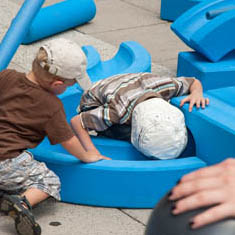Above: These children want the ball to roll on its own rather than roll by pushing it along with their hands.
So they start the ball even higher than the chute by using the open hole in a tall vertical block.

The children roll the ball through the hole as a tunnel. But to increase the time the ball disappears, they extend the tunnel by using extra chutes. The ball turns the holes into an event with surprise—the ball pops out.

The children test the limits of how many curves the ball will roll through without being pushed. They discover that the curves slow the ball down quite a bit. It is not as much fun to push the ball by hand.
What It Means
The curve of a block has an attractive look, but if it is a chute that directs the movement of a ball, it now has a function as well. A rolling ball gives form a purpose, a consequence. The movement of the ball makes the child think what comes next, i.e. a higher place or a lower place. This sequence matters now, because low to high stops the ball but high to low makes it roll faster. The ball’s movement also causes the child to think about the continuity of the blocks (are there gaps that would trap the ball?), and about the curves of the blocks (will the ball fly out of the track?). All in all, balls transform the static beauty of a structure into a system of causes that direct, deflect, trap, slow, and speed the movement of the ball. Therefore more thinking is required to make the structure “work.”
The rules of ball play also look different across the ages, with the younger children playing simple games of “my turn, then your turn,” and the older children setting up rules that make winning and losing possible, such as, “My ball will get to the finish line first,” or, “You have to have the ball when you tag me or it does not count.”
2-4 Year Olds
Young toddlers will find it a challenge to hold a spherical object. They might be seen walking proudly holding the ball. Holding two balls offers a particular satisfaction. They may put one in each hand, and then bang them together. They will also look for someone to play toss.
4-7 Year Olds
Older children will probably want to roll the ball across the floor or yard as far as it will go. Distance is more their objective than a target. Targets can come with a little encouragement.
7-10 Year Olds
Older children will understand the way inclines work, and will “read” the Chutes as a possible down-ramp for the balls. As you see in the photographs, they test the limits of how far the roll and how complex the path each drop of a ball can complete. They will be reluctant to push the ball, but will do so just to see the ball get to the end of the path.
This material is adapted from the publication “Imagination Playground’s Guidance to Play” by George E. Forman, PhD, Emeritus Professor, University of Massachusetts (Amherst) and President of Videatives, Inc.
Dr. Forman has over 33 years of experience in university teaching, cognitive research, multimedia design and educational consulting in the area of early childhood learning and development.
“Guidance to Play” covers 20 topics that help illustrate the significance in what children are doing as they play as well as concrete actions Play Associates can take to facilitate positive behaviors.



